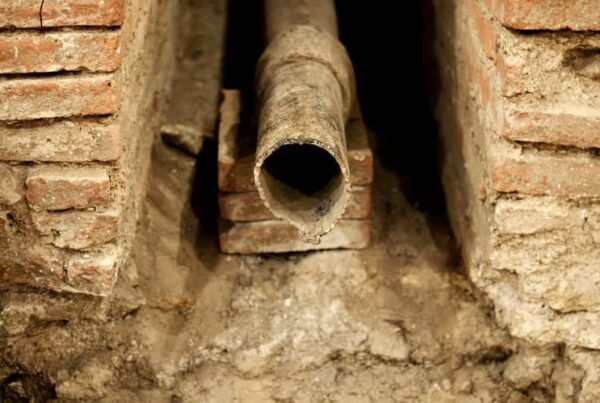
Cast Iron Background
Cast Iron drains were commonly installed before the 1970’s. During this time, cast iron was said to be a 50 year life-span, however, with many slab-on-grade homes the life can be limited to as soon as 25 years of life.
Ultimately, today, cast iron drain lines are reaching their life expectancy. It’s not a matter if it should be replaced, but when it should be replaced.
Cast Iron Problems
Cast iron corrodes from the inside out. Therefore, from the outside the pipe could look to be in perfect condition. However, on the inside with water flow and chemicals, the consistent wear causes rust and damage.
As time passes, rainwater can enter your plumbing drainage system through vent stacks. (Vent stacks emit sewer gases on the roof. The opening also allows for better water flow underneath your home.) After years and years of just rainwater, the inside of the cast iron drains can become worn.
Here is a list of other items that can affect cast iron drains:
- Ground movement – soil movement
- Tree growth – roots can damage pipes
- Moisture in the ground.
The most common damage to pipes is from consistent sewer flow that rusts the inside of the pipe or tress which roots damage/crack the pipes.
What happens to damaged Cast Iron Drains?
Once the cast iron is damaged, leaking sewage can end up underneath your home causing possible structural damage. Also, roots inside the cast iron can lead to backups.
If you are lucky, the broken portions of cast iron may only be outside your home which is a much easier repair/replacement.
Obtaining Insurance
Trying to request homeowner’s insurance with cast iron drains can be difficult as well. Many insurance companies may require higher insurance premiums or ask you to replace it.
It is important to speak with your insurance agent or different companies to find out their process for moving forward.
A four-point inspection, which is an insurance required inspection, might reveal to your insurance company that you have cast iron drain lines.
Sewer Camera/Scope
Many homebuyers can purchase a sewer camera/scope inspection alongside their home inspection if they are concerned about cast iron. Homeowners, can order this type of service as well.
The sewer scope takes a look inside the pipes to find out the condition which can help the buyer/homeowner decide how big of an urgency replacing the plumbing drain system is.
Below is a picture from a sewer camera by Honor Services that exhibits roots growing into the cast iron drain lines.

This type of damage is definitely causing leaks, backups, and possible future structural damage.
Watch this video on Why Replace Cast Iron
Costs to Replace Cast Iron Drains
Replacing cast iron drain lines is not a simple process. The cost can range from the low end of a few thousand to thousands of dollars depending on home location and location of the cast iron.
If cast iron is underneath a concrete slab, all the concrete will have to be jackhammered in order to expose the pipes. Next, the pipes will have to be replaced, as well as, replacement of all interior features, such as tiles or cabinets.
Some more experienced plumbers can replace cast iron with less intrusive tactics. This can lead to easier installation methods like digging underneath the slab from the outside which can protect your flooring and interior components.
If you are looking to replace cast iron, you should definitely call several plumbers to find their experience level. A homeowner would not want their concrete flooring to be exposed for long.
Alternatives to Cast Iron

Today, PVC is the most highly used drainage system. Most plumbers that repair/replace cast iron drains will replace it with PVC.
“Slip” Lining Cast Iron
There has been talk about a type of repair to cast iron that “shoots” a liner down cast iron. The liner blows up like a balloon which ultimately covers all deficiencies of cast iron. However, the installs have been limited which limits real world data to life expectancy, insurance acceptance, and of any side effects.
Here is a source that does lining of cast iron. They claim to have a 50-year warranty, shorter install time, half the cost, and to comply with regulations.
Homeowners should carefully consider before choosing this option though. Lining an already damaged pipe causes the new pipe to be of smaller size and thickness. Also, the real world data of its effectiveness is just not out yet.
Here is a video on Lining Cast Iron
If you do have slip lining cast iron be sure to let us know how it working for you because we want to know! 🙂
Have a question? Comment below.



